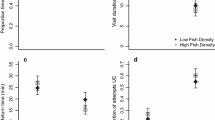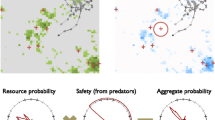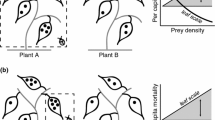Abstract
In a heterogeneous environment containing multiple patches that may deplete and renew, a forager should be able to detect the quality of food resources within and among patches and choose to exploit them to best maximize returns. From the predator’s perspective, the behavioral responses of the prey in a patch will be perceived as depletion when they retreat to refuge and renewal when they reemerge. A predator encountering responsive prey should manage predation risk, and thus behavioral resource depression, by optimally timing its return time to the patch based on prey behavior. We evaluated the foraging decisions of a predator that encountered patches differing in size of the refuge and prey density. We used little egrets and goldfish as predators and prey in an environment that contained three patches (pools). We manipulated prey density and refuge size and availability (using covers) and observed predator foraging behavior. When the egret had previously caught a fish it did not discriminate between the pools, and the return time was similar for all cover types. The fish densities also did not affect the egret decisions to return to pools. However, when it failed to catch fish, it returned sooner to the pool containing the small cover than the larger one. Additionally, after failing to catch fish in patches containing the highest prey density, the egrets subsequently preferred to return to such patches sooner. We show experimentally that previous failures influence the foraging decisions of a predator choosing how quickly to return to a previously visited patch.





Similar content being viewed by others
References
Balaban-Feld J, Mitchell WA, Kotler BP, Vijayan S, Lotan TT, Abramsky Z (2019) State-dependent foraging among social fish in a risky environment. Oecologia. https://doi.org/10.1007/s00442-019-04395-z
Beauchamp G (2003) Group-size effects on vigilance: a search for mechanisms. Behav Process 63:111–121
Berger J (1979) “Predator harassment” as a defensive strategy in ungulates. Am Midl Nat 102:197–199
Berger-Tal O, Mukherjee S, Kotler BP, Brown JS (2010) Complex state-dependent games between owls and gerbils. Ecol Lett 13:302–310
Botham MS, Kerfoot CJ, Louca V, Krause J (2005) Predator choice in the field; grouping guppies, Poecilia reticulata, receive more attacks. Behav Ecol Sociobiol 59:181–184
Brown JS (1992) Patch use under predation risk: I. Models and predictions. Ann Zool Fennici 29:301–309
Brown JS, Mitchell WA (1989) Diet selection on depletable resources. Oikos 54:33–43
Brown JS, Laundre JW, Gurung M (1999) The ecology of fear: optimal foraging, game theory and trophic interactions. J Mammal 80:385–399
Caraco T (1981) Energy budgets, risk and foraging preferences in dark-eyed juncos (Junco hyemalis). Behav Ecol Sociobiol 8(820):830
Caraco T (1983) White crowned sparrows (Zonotrichia leucophrys): foraging preferences in a risky environment. Behav Ecol Sociobiol 12:63–69
Charnov EL (1976) Optimal foraging, the marginal value theorem. Theor Popul Biol 9:129–136
Charnov EL, Orians GH, Hyatt K (1976) Ecological implications of resource depression. Am Nat 110:247–259
Cresswell W (1994) Flocking is an effective anti-predation strategy in redshanks, Tringa totanus. Anim Behav 47:433–442
Cresswell W, Hilton GM, Ruxton GD (2000) Evidence for a rule governing the avoidance of superfluous escape flights. Proc R Soc Lond B Bio Sci 267:733–737
Devenport JA, Devenport LD (1994) Spatial navigation in natural habitats by ground-dwelling sciurids. Anim Behav 47:727–729
Elgar MA (1989) Predator vigilance and group size in mammals and birds: a critical review of the empirical evidence. Biol Rev 64:13–33
Fortin D, Boyce MS, Merrill EH (2004) Multi-tasking by mammalian herbivores: overlapping processes during foraging. Ecology 85:2312–2322
Foster WA, Treherne JE (1981) Evidence for the dilution effect in the selfish herd from fish predation on a marine insect. Nature 293:466–467
Freidin E, Kacelnik A (2011) Rational choice, context dependence, and the value of information in European starlings (Sturnus vulgaris). Science 334:1000–1002
Giraldeau LA, Caraco T (2000) Social foraging theory. Princeton University Press, Princeton
Godin J-GJ, Crossman SL (1994) Hunger-dependent predator inspection and foraging behaviours in the threespine stickleback (Gasterosteus aculeatus) under predation risk. Behav Ecol Sociobiol 34:359–366
Green RF (2006) A simpler, more general method of finding the optimal foraging strategy for Bayesian birds. Oikos 112:274–284
Hammond JI, Luttbeg B, Sih A (2007) Predator and prey space use: dragonflies and tadpoles in an interactive game. Ecology 88:1525–1535
Hansen MJ, Schaerf TM, Ward AJ (2015) The effect of hunger on the exploratory behaviour of shoals of mosquito fish Gambusia holbrooki. Behaviour 152:1659–1677
Hilton GM, Cresswell W, Ruxton GD (1999) Intraflock variation in the speed of response on attack by an avian predator. Behav Ecol 10:391–395
Hugie DM (2003) The waiting game: a “battle of waits” between predator and prey. Behav Ecol 14:807–817
Ioannou CC, Tosh CR, Neville L, Krause J (2008) The confusion effect-from neural networks to reduced predation risk. Behav Ecol 19:126–130
Ioannou CC, Morrell LJ, Ruxton GD, Krause J (2009) The effect of prey density on predators: conspicuousness and attack success are sensitive to spatial scale. Am Nat 173:499–506
Iwasa Y, Higashi M, Yamamura M (1981) Prey distribution as a factor determining the choice of optimal foraging strategy. Am Nat 117:710–723
Jeschke JM (2007) When carnivores are full and lazy. Oecologia 152(2):357–364
Katz MW, Abramsky Z, Kotler BP, Altstein O, Rosenzweig ML (2010) Playing the waiting game: predator and prey in a test environment. Evol Eco Res 12:793–801
Katz MW, Abramsky Z, Kotler BP, Rosenzweig ML, Alteshtein O, Vasserman G (2013) Optimal foraging of Little Egrets and their prey in a foraging game in a patchy environment. Am Nat 181:381–395
Katz MW, Abramsky Z, Kotler BP, Roth I, Livne S, Altestein O, Rosenzweig ML (2014) A predator–prey foraging game: how does prey density influence tactics? Evol Eco Res 16:323–335
Koops MA, Abrahams MV (2003) Integrating the roles of information and competitive ability on the spatial distribution of social foragers. Am Nat 161:586–600
Kotler BP, Brown JS, Dall SRX, Gresser S, Ganey D, Bouskila A (2002) Foraging games between owls and gerbils: temporal dynamics of resource depletion and apprehension in gerbils. Evol Eco Res 4:495–518
Kotler BP, Brown JS, Bouskila A (2004) Apprehension and time allocation in gerbils: the effects of predatory risk and energetic state. Ecology 85:917–922
Krakauer DC (1995) Groups confuse predators by exploiting perceptual bottlenecks: a connectionist model of the confusion effect. Behav Ecol Sociobiol 36:421–429
Krause J, Godin JJ (1995) Predator preferences for attacking particular prey group sizes: consequences for predator hunting success and prey predation risk. Anim Behav 50:465–473
Krause J, Ruxton GD (2002) Living in groups. Oxford University Press, Oxford
Lemasson BH, Tanner CJ, Dimperio E (2016) A sensory-driven trade-off between coordinated motion in social prey and a predator’s visual confusion. PLoS Comput Biol 12(2):e1004708
Lima SL (1994) On the personal benefits of anti-predatory vigilance. Anim Behav 48:734–736
Lima SL (1995) Back to the basics of anti-predatory vigilance: the group size effect. Anim Behav 49:11–20
Lima SL (2002) Putting predators back into behavioral predator-prey interactions. Trends Ecol Evolut 17:70–75
MacArthur RH, Pianka ER (1966) On the optimal use of a patchy environment. Am Nat 100:603–609
Marshall HH, Carter AJ, Ashford A, Rowcliffe JM, Cowlishaw G, Boots M (2013) How do foragers decide when to leave a patch? A test of alternative models under natural and experimental conditions. J Anim Ecol 82:894–902
McNamara JM (1982) Optimal patch use in a stochastic environment. Theor Popul Biol 21:269–288
Oaten A (1977) Optimal foraging in patches: a case for stochasticity. Theor Popul Biol 12:263–285
Olsson O, Brown JS (2006) The foraging benefits of information and the penalty of ignorance. Oikos 112:260–273
Olsson O, Holmgren NMA (1998) The survival-rate-maximizing policy for Bayesian foragers: wait for good news. Behav Ecol 9:345–353
Pulliam HR (1973) On the advantages of flocking. J Theor Biol 38:419–422
Pyke GH, Pulliam HR, Charnov EL (1977) Optimal foraging-selective review of theory and tests. Q J Biol 52:137–154
Rodrigues-Girones M, Vasquez RA (1997) Density dependent patch exploitation and acquisition of environmental information. Theor Popul Biol 52:32–42
Sih A (1998) Game theory and predator–prey response races. In: Dugatkin LA, Reeve HK (eds) Game theory and animal behavior. Oxford University Press, Oxford, pp 221–238
Stephens DW, Krebs JR (1986) Foraging theory. Princeton University Press, Princeton
Treves A (2000) Theory and method in studies of vigilance and aggregation. Anim Behav 60:711–722
Valone TJ (1991) Bayesian and prescient assessment: foraging with pre-harvest information. Anim Behav 41:569–577
Valone TJ (2006) Are animals capable of Bayesian updating? An empirical review. Oikos 112:252–259
Valone TJ, Brown JS (1989) Measuring patch assessment of desert granivores. Ecology 70:1800–1810
Vardi R, Abramsky Z, Kotler BP, Altstein O, Rosenzweig ML (2017) How does the presence of a conspecific individual change the behavioral game that a predator plays with its prey? Oecologia 184:597–607
Vijayan S, Mitchell WA, Kotler BP, Rosenzweig ML, Balaban-Feld J, Lotan TT, Abramsky Z (2018a) A predator–prey foraging game in experimental aviaries: effects of the number of goldfish and refuge size. Evol Ecol Res 19:333–352
Vijayan S, Mitchell WA, Kotler BP, Rosenzweig ML, Balaban-Feld J, Lotan TT, Abramsky Z (2018b) The influence of manipulated risk of predation on a predator-prey foraging game in a patchy environment: egret and goldfish in experimental aviaries. Evol Ecol Res 19:319–332
Vijayan S, Mitchell WA, Rosenzweig ML, Kotler BP, Balaban-Feld J, Lotan TT, Abramsky Z (2018c) Influence of prey food abundance on predator-prey foraging games: a test with little egrets and goldfish. Evol Ecol Res 19:455–468
Vine I (1973) Detection of prey flocks by predators. J Theor Biol 40:207–210
Wolf N, Mangel M (2007) Strategy, compromise, and cheating in predator–prey games. Evol Eco Res 9:1293–1304
Acknowledgements
We thank Israel Science Foundation Grant 05/14 to Zvika Abramsky for supporting this research. We thank Avi Koplovich, Ofir Altstein, and Reut Vardi for their assistance with the experimental design and data collection in the aviary. We are grateful to Shiraz Cohen for her help in python programming in extracting the behavioral data from excel files. Yulia Dubinsky, Aviv Gruber, Anjala Pyakurel, Yulia Nekin, Marina Nochevny, Michal Elul and Mor Peled helped with video data extraction. We thank two anonymous referees for comments that greatly improved the paper. SV is grateful to the Azrieli Foundation for the award of an Azrieli Post-Doctoral Fellowship at Ben-Gurion University.
Author information
Authors and Affiliations
Contributions
WAM and ZA conceived and designed the experiments. TTL, SV, and JKL performed the experiments. SV, JKL, JB and ZA analyzed the data. SV, JB, BPK, and ZA wrote the manuscript. MLR, in addition to editorial advice, provided important theoretical and intellectual contributions that significantly improved the study.
Corresponding author
Ethics declarations
Conflict of interest
The authors declare that they have no conflict of interest.
Ethical approval
All applicable institutional and/or national guidelines for the care and use of animals were followed.
Additional information
Communicated by Hannu Pöysä.
Electronic supplementary material
Below is the link to the electronic supplementary material.
Rights and permissions
About this article
Cite this article
Vijayan, S., Lee, J.K., Balaban-Feld, J. et al. Time to revisit? A predator’s previous successes and failures in prey capture determine its return time to patches. Oecologia 190, 387–397 (2019). https://doi.org/10.1007/s00442-019-04425-w
Received:
Accepted:
Published:
Issue Date:
DOI: https://doi.org/10.1007/s00442-019-04425-w




